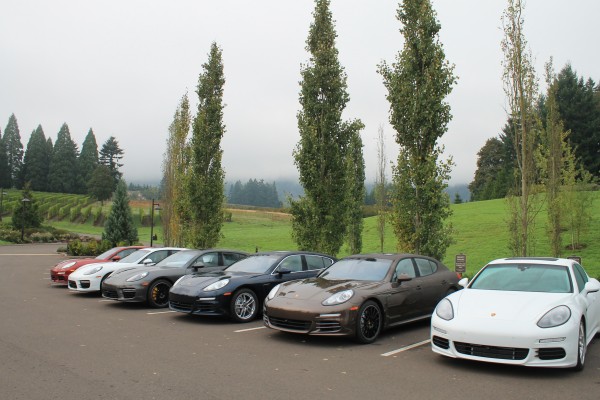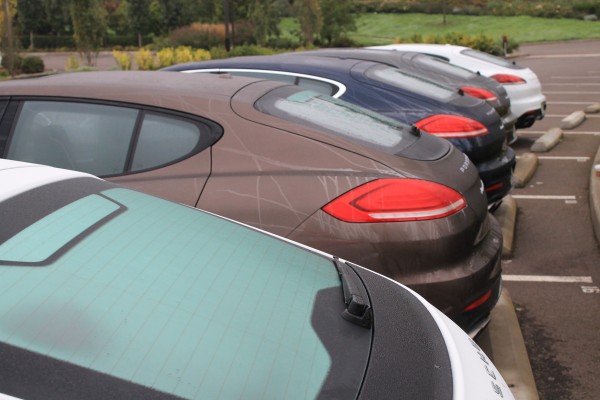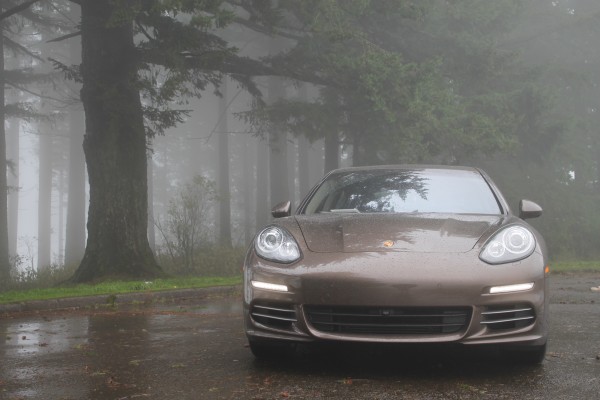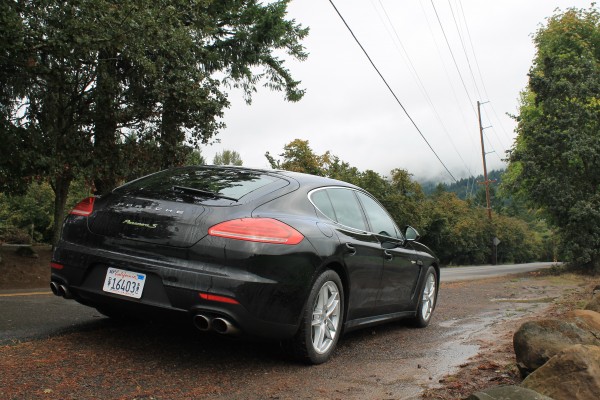The Panamera has been a subject of ongoing derision among some Porsche fans since it was introduced in 2009. We’ve heard the uninitiated say things like, “It’s not a ‘real’ Porsche”, or that “it dilutes the brand’s history”. I’m here to tell you that after spending two days immersed in the Panamera line-up that even if I might somewhat agreed with this negative opinion before, I can tell you now that I was completely wrong. Here’s why.
Last week, Porsche invited FLATSIXES.com to test the new Panamera models introduced for 2014. Predominantly, Porsche wanted to give us hands on experience with the new more-efficient 3.0 liter turbocharged V6 in the Panamera S and 4S models, the new plug-in Panamera S E-hybrid, and the long-wheelbase Panamera Executive (available in 4S and Turbo guise), though there were updated versions of the existing Turbo and GTS available for our appraisal as well.
When told that the event would take place in Newberg, Oregon, my first thought was ‘Why Oregon?’, but after a minute or so to mull it over that changed to ‘Why the hell not?’. Having never been to Oregon, and seriously wanting an opportunity to test out the new tech, I packed my bags and headed for the west coast. My opinion of both Porsche’s 4-door and the rainy hills of Oregon were about to be changed for the better.
What To Expect In This Post
First, this post is not a review of each individual model. Instead, it’s a look at the line-up as a whole. I’ll discuss all of the changes and new options available across the Panamera range for 2014, then at the end of this post, you’ll find links to individual reviews on the driving experience provided by each model, independent of its brothers. In addition to new sheetmetal, Porsche added some noteworthy tech to the options list, and the new Panameras are an altogether better car for it.
Let’s Get Started
Beginning with the new sheetmetal dressing, the Panamera now has restyled headlamps and a more aggressive front bumper with deeper cut brake ducts and a larger central grille. This new bumper pairs well with the enlarged power bulges introduced on the hood. For the most part, the side view is similar to the outgoing model, but introduces new crisper side view mirrors, as well as a more pronounced edge along the lower rocker panel below the doors. The majority of the change comes in the rear view, with a new rear bumper profile, moving the license plate area lower, below the painted section, accenting the updated rear lamps and tailpipes. The rear hatch opening is similar in size, but the hatch itself now has an enlarged rear window creating an improved view out the back. [each of the three slides below show the old Panamera on the left and the new model on the right with the red color highlighting the changes explained in the captions].

The front bumper has been flattened, and the power bulge on the hood has been given a more pronounced appearance.
The soft light and background fog engulfing the hills around Newberg were the perfect juxtaposition for the pronounced and strangely attractive curved flanks of the Panamera. The mountain road routes suggested for us were certainly entertaining, and switchbacks always seem to fit together with fastbacks like the pieces of a puzzle. The Michelin Pilot Super Sports fitted to each of the demonstration cars seemed to eat up the corners with nothing shy of aplomb, even when taxed with two tons of hefty Porsche. Throughout the two days of driving, the rain only stopped a handful of times for about 15 minutes each, and managed to litter the roads with copious excommunicated canopy foliage, eroded earth, and many spates of standing water, which the tires also seemed to manage with relative ease.

The daytime running lights have been moved up to just below the new headlamps, the three front air inlets have all been enlarged to produce an increasingly aggressive design.
In the tech department, all Panameras now have several optional assistance systems that are quite interesting. Adding to the alphabet soup that can be found on a Porsche order form, ‘PDLS Plus’ (Porsche Dynamic Lighting System) now offers a full LED lamp with dynamic high beams and junction lamps. The center stack display can now show an aerial display 360 degrees around the car in parking situations, assisting with the driver’s endeavors to make harbor for his Porsche-branded barge. The new lane-departure system identifies markings on the road and audibly warns the driver that they are about to drift out of the lane. I found this particular system more annoying than useful, though, to be fair I was driving quite narrow roads. The lane departure is defeatable by use of a simple button. The more useful of the new systems, include a small lamp in each exterior rear view mirror surround which illuminates when a car is in your blind spot, as well as the ability to track the posted speed limits through the gps display in the gauge cluster.
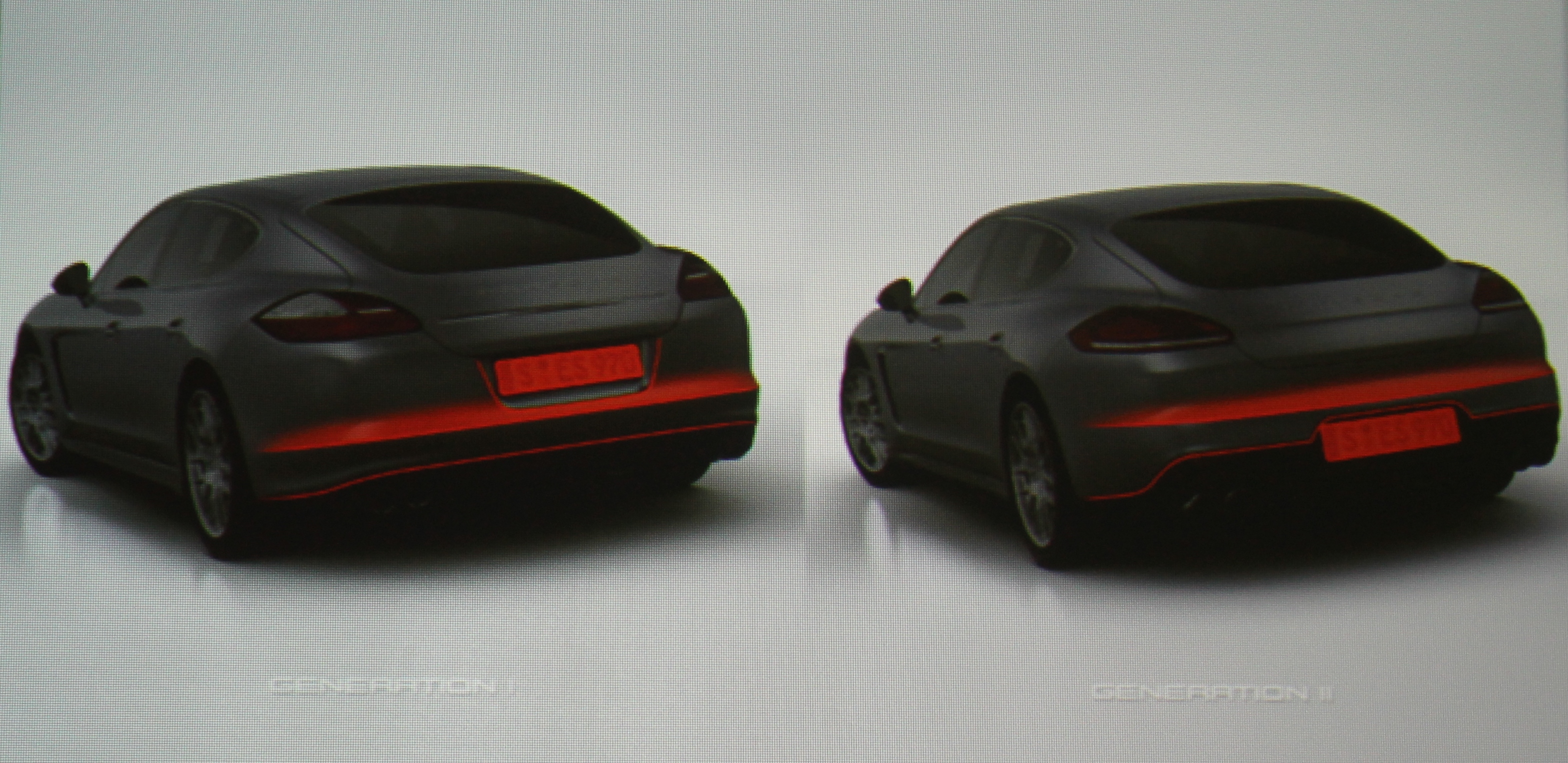
The rear bumper profile has been reshaped, the rear window has been enlarged, the tail lamps have been modified, and the number plate has been moved lower.
Porsche has also introduced a new system called Porsche Car Connect, in which your smartphone can be connected to your car to display all of the vital information you may need, even remotely. Your Panamera can now be locked and unlocked via your phone, it can be tracked when stolen or lost, and you can transmit walking directions to find your parked car after a day of shopping. Additional features of Car Connect are standard on the Panamera S E-hybrid, but I will delve into those further in a later feature.
Every 2014 Panamera has been fitted with a small handful of new tech to aid in the fuel efficiency of each car sold. New “coasting” function allows your Panamera engine to decouple from the PDK transmission and ride along at just above idle during all 0% throttle conditions. When the car comes to a complete stop, the engine is then completely shut off until the driver’s foot is removed from the brake pedal, at which point, the engine barks back to life just in time for your foot to rock over to the loud pedal. Both features take just a little getting used to, but once accustomed, they fade to near seamless.
In between bouts of driving the Panamera lineup, Porsche treated me to delicious food, a trip to a local winery, and loads of great conversation among those in the media and those in the company’s employ. It was an excellent trip, and all of us at FLATSIXES.com were grateful for the invite.
Here are nine additional excerpts from my notebook that may be of interest:
- As a tall person (6’2″), I found it somewhat difficult to see the markings on the overhead switchgear. Opening the sunroof took a bit of getting used to.
- The optional “soft close doors” are a neat feature, using an electronic latching mechanism to finish closing the doors. This makes door closing a quiet endeavor rather than a loud slam.
- Optional lighted door sills are a nice touch, but remain unseen the majority of the time.
- The optional Burmeister audio system sounds phenomenal, but I’m unsure it is worth the additional five-thousand dollars over the Bose system.
- The door switches are easily in reach, but are mounted low on the door and not entirely intuitive.
- The new exterior rear view mirror shape makes for an odd reflecting surface, but the mirrors are large, and give a nice view of what lies behind.
- Cupholders are sufficient for the US market, surprising in a German car. One in the front center console, two in the rear center console, and two can holders in the passenger side dashboard.
- At a full lock u-turn, the 20 inch wheels just barely rubbed against the inner side of the wheel wells.
- The rear hatch release has been relocated to a button on the rear windscreen wiper when so equipped. This is a very easy spot to reach, and has made opening the hatch just a little bit more convenient.
Read our 2014 Porsche Panamera 4S Review
Read our 2014 Porsche Panamera S E-hybrid Review
Read our 2014 Porsche Panamera GTS Review
Read our 2014 Porsche Panamera Turbo Executive Review
Read our 2014 Porsche Panamera S Review
